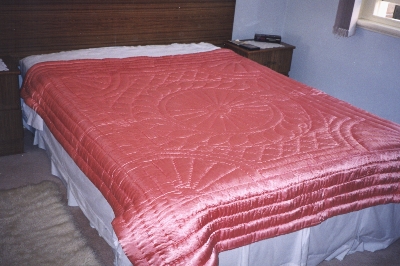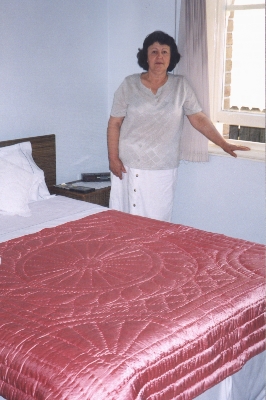Quilt No.779MA - Maria Ahilas

2000 x 1600mm
The quilt was made by a local quiltmaker, Mr. Karagas, in 1963 in Mytilini the capital of Lesvos, Greece. Maria Loutragoto (later Ahilas) brought it to Australia as part of her luggage in 1963. Maria has always owned it.
"A Paploma from Mytilini
Maria Loutragoto, as a young woman in her twenties, was preparing, in 1963, to leave her village of Paliokipo on the beautiful Gulf of Yera, Lesvos, Greece's third largest island, to make the long journey to Australia. Her fiance of three years, Lambrou Ahilas, was already in Australia, so a top priority for Maria was the assembling of her 'prika' (trousseau) to bring with her. And this, true to Greek tradition, included a 'paploma' (quilt). 'You wouldn't even think of getting married without a paploma, all the girls had at least one - and it's still the same today, only now they buy the ready-made ones.'
Maria's paploma was to be a wedding gift, so she and her mother Mersini went to the 'paplomatas' (quiltmaker) Mr. Karagas in Odos Ermou, Mytilini, capital of Lesvos. Maria chose the beautiful, pink satin fabric and the quilting pattern; and remembers that about five and a half kilos of raw cotton (grown on the island) was used as the wadding.
The early years in this 'xeni hora' (foreign place) were extremely difficult for Maria and for several years she thought only of returning to her homeland, but Lambros liked Australia right from the start, so Maria gradually adapted and can now talk about feeling happy and very satisfied with her life in Australia. Their early years of hard work and frugal living have enabled them to achieve much, and in particular to give their children a good education - Theodora is a solicitor, and Mersini is a primary school teacher.
Even though Maria uses her paploma when visitors come, it is still in excellent condition. Somehow it represents her life journey - originating in Mytilini, travelling with her on the migrant ship 'Patris', then through her years of marriage and children, and now reaching out to their two grandchildren, Joseph and Marianna."
[Written by Lula Saunders; adapted from interview 2/1/01 for the National Quilt Register]

Related Quilts:
2200 x 1840mm
1750 x 840mm
1960 x 1950mm
2033 x 1474mm






